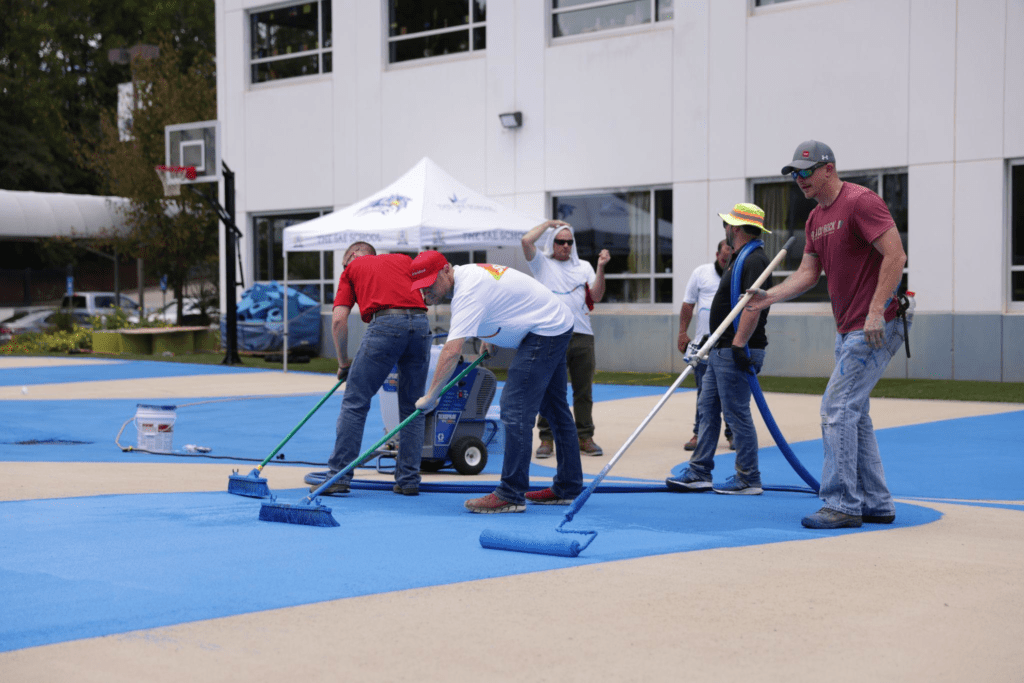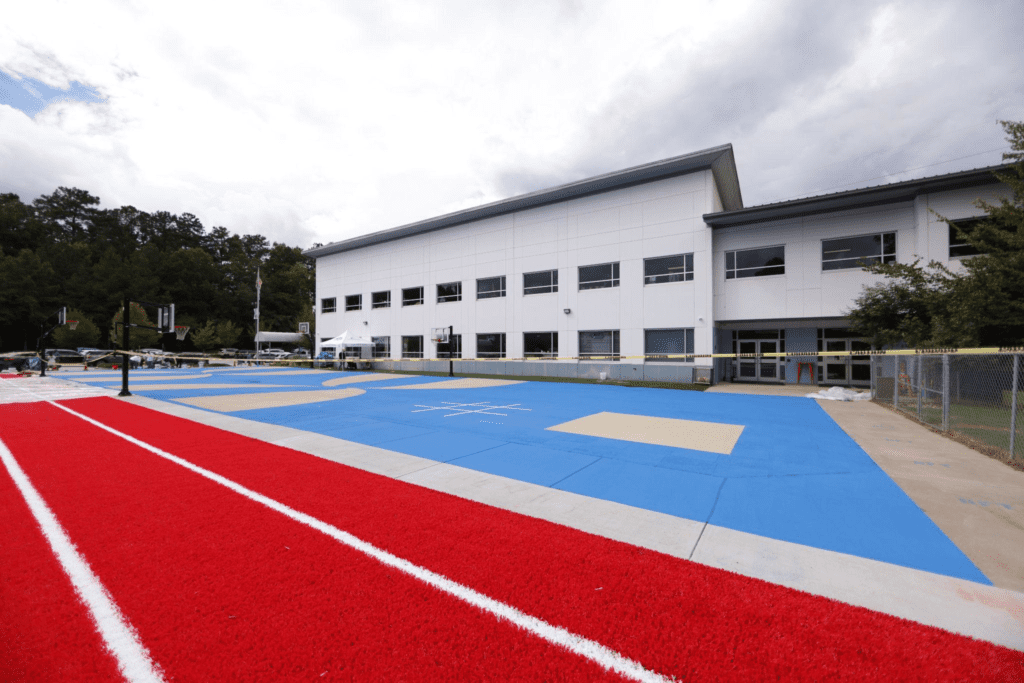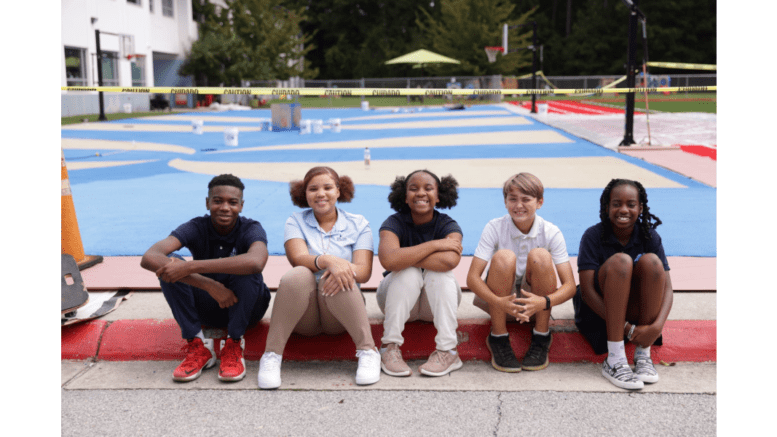By Arielle Robinson
As extreme heat continues to result in historic droughts and deadly temperatures around the globe, more people — especially the most vulnerable, such as children — are beginning to see and feel the impacts of climate change.
The SAE School, a green private school in Mableton for preschool through eighth grade, has collaborated with StreetBond to mitigate the effects of the extreme heat on its students.
Thursday morning and afternoon, a crew from StreetBond applied a blue solar-reflective coating at the SAE School’s basketball court and playground. The crew began doing this Tuesday and finished Friday. The coatings lower the ground surface temperature by around 10-12 degrees.



SAE students helped measure the data and design the coating, which is after the school mascot, a blue dragon.
The younger children submitted ideas for what they wanted the court design to look like and voted on the final idea. Older students actually measured temperatures and compared the blacktop temperature to the solar-reflective coated surface temperature.
The basketball court was originally a blacktop which became very hot as temperatures swelled in the metro Atlanta area.
Eliot Wall is the general manager of StreetBond. StreetBond is a business unit of GAF, North America’s biggest roofing and waterproofing manufacturer. GAF invested money into mitigating the effects of heat in urban communities. StreetBond works to reduce surface temperatures in public and private areas like schools, parks, bike lanes, and more.
They have worked at over 130 schools across the United States.
The process at SAE has been about a year in the making.
“What we did is we came down late last year and started working with [SAE],” Wall said. “What we did is we partnered with them and said, ‘we don’t want to just do your project, we want you to be part of it.’ So we had the kids actually design what was going to be put down.
“We’ve been coming down over the past couple of months and we actually did a little demo over in a parking spot where we had them measure the temperature of the asphalt before, and then we put down the coating and measured it after. We left it there and every day since they’ve been coming out and measuring it.”
Wall said the students have collected two months’ worth of data that shows the differences in temperature.
The coating, which comes in 14 colors, has an additive in it called invisible shade technology which reduces the surface temperature by 10 to 12 degrees.
No matter what color is chosen — lighter or darker — the technology works the same.

Wall said that normally, asphalt absorbs heat, making the ground and surrounding temperature hotter.
“What the coating does is it reflects solar energy,” Wall said. “And we have our additive, it’s not just visible light spectrum, which is typically what happens — you’ll see white coatings that reflect light. Ours actually works within the infrared spectrum to reflect that light, that energy.
“…Because all of the energy from the spectrum of light is just radiation — different parts of it you can see, other portions of it you can’t, like ultraviolet and infrared — this works on multiple levels of that spectrum to reduce the amount of radiation heat energy that’s being stored in the pavement.”
Wall pointed to the necessity of a program like this. It is the first of its kind in the metro Atlanta area.
“I know in Atlanta and the urban area, the expected temperatures are supposed to increase significantly over the next 15 years,” Wall said. “But Atlanta is not unique in this, as we know 85 percent of all Americans live in an urban area. And as we’ve seen this summer, Europe is in its worst drought in 500 years. This is a global issue for all of us. Heat is in fact the leading weather-related adverse impact and injury for health outcomes.”
Wall and SAE school officials also pointed to the effects of heat on children in schools. They all say that efforts to reduce temperatures improve children’s health.
“What we’ve seen elsewhere in other schools…is that when you go from having a blacktop before to having it be something really vibrant and colorful it is not only cooling but also cool to actually hang out on,” Wall said. “Kids have greater socialization, they have greater physical activity, which is actually leading to higher test scores as well and better behavior in class and less bullying.”
Kids will be able to play on the new surface as early as next week.
SAE Head of Schools Desmond Bobbett said that due to the heat index and heat stipulations, they have sometimes had to cut students’ outside time short.
SAE CFO Scott Starowicz said the coating can help extend students’ outdoor time.
Starowicz said the design process connects to SAE’s mission and name — SAE stands for science, arts, and entrepreneurship.
“It gives that hands-on approach to learning and now [the students] can see it on a larger scale,” Starowicz said.
Bobbett also said the design process can help prepare students for future environmental careers.
“Many students may not have the thought of going into sustainability and energy-saving and those kinds of careers,” Bobbett said. “So hopefully, we’re planting the seed so those students can see that there is a benefit to it and it could be a lucrative career for them as well.”
Starowicz said this is SAE’s 10th school year. The school started exploring sustainability options about four years ago, when they began to acquire solar panels and create energy-efficient units.
The SAE School is the first school in the state of Georgia to run 100 percent on solar power. It has an entire page on its website dedicated to sustainability.
A group of seventh and eighth graders from the school said being part of the design process was enjoyable. They said measuring the temperatures was fun in particular.
“The paint also has sand mixed into it, so it helps with traction and shoes so kids don’t slip,” seventh-grader Wes Tilson said.
Eighth-grader Christian Taylor said students have been measuring temperatures since late June. Taylor said surface temperatures were cooler on cloudy days.
The students said that the hotter temperatures as of late have negatively impacted them and their peers at school.
“A lot of more kids are wanting to go inside quicker and they get tired real quick when outside,” Tilson said.
The students agreed that going outside in the summer is not as enjoyable anymore.
Eighth-grader Munachi Afulezi said that with the paint, kids who play outside can feel more relief from the weather.
“The paint will help once [the surface] is cooler,” Afulezi said. “It won’t be as much of a burden to go outside and you’ll be able to enjoy it more…I think it’s been a good project for the past summer. It was really fun doing this over time, so it’ll be interesting to see how it all turns out.”
